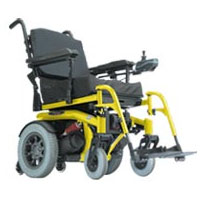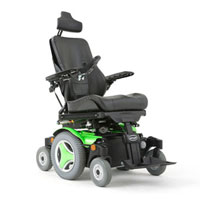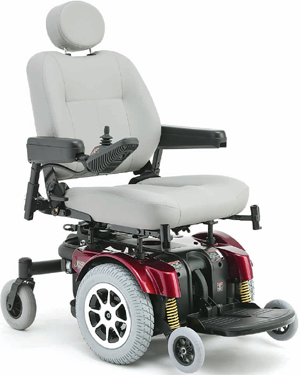
When choosing a wheelchair, whether electric or manual, it’s important to consider the user’s needs and preferences, as well as the environment in which the wheelchair will be used. Factors such as the user’s weight, height, and level of mobility should also be taken into account. It is also important to consider the user’s daily activities, the terrain where the wheelchair will be used and the duration of use.
This guide will provide an overview of electric wheelchairs and their various features, as well as information on drive systems, power vs manual wheelchairs, wheels and tires, controllers, batteries, medical insurance, maintenance and repairs, electric wheelchair brands, suppliers, and more.
What to Expect from This Guide
In this guide, we will go over:
- Power vs. Manual Wheelchairs
- Types & Configurations of Electric Wheelchairs
- Drive Systems
- Wheels and Tires
- Controllers/Joysticks
- Electric Wheelchair Batteries
- Medical Insurance
- Other Considerations
- Maintenance & Repairs
- Electric Wheelchair Brands
- Electric Wheelchair Companies
- Conclusion
- Electric Wheelchair FAQs
- Electric Wheelchair Resources
Power Vs Manual Wheelchairs
Manual wheelchairs are powered by the user, who propels themselves by pushing on the wheels with their hands. They are typically less expensive than electric wheelchairs and require less maintenance. However, manual wheelchairs can be more physically demanding, and may not be suitable for individuals with limited upper body strength or mobility.
Power wheelchairs, on the other hand, are powered by an electric motor and controlled by a joystick or other type of controller. They offer more flexibility and independence, as the user does not have to rely on their own physical strength to propel the wheelchair. Electric wheelchairs are also more versatile and can be used indoors and outdoors. They also tend to have more advanced features, like power seating, adjustable leg rests, and elevating seats, which can make the user more comfortable. However, they are typically more expensive and require more maintenance than manual wheelchairs.
In most cases, you’ll have a choice between a manual (powered by the individual) or electric (wheelchair w/ external power supply). This choice will often be the easiest, as you may be forced into one or the other for economic or physical reasons. You’ll then need to determine what you’ll be using the wheelchair for. This is where it can become a bit more difficult and it may be necessary to consult with an occupational or physical therapist.
Here are a few questions to ask
Here are some factors to consider when choosing between an electric or manual wheelchair.
- What are the user’s daily activities?
- How long will the wheelchair be used each day?
- How much upper body strength does the user have?
- Is the user able to propel a manual wheelchair independently?
- Is the wheelchair for indoor or outdoor use?
- How important is maneuverability?
- Do you need it to fold?
- How easily can it be transported?
- Are there any weight requirements?
- Are there any seating requirements?
- Are there any speed requirements?
- Cost, how affordable is it?
It also may be a good idea to speak with other individuals who have purchased or have used a power wheelchair in the past. They’ll be able to give you some of the best advice and recommendations. Ultimately, the user should give the wheelchair a test drive before a purchase is made. This doesn’t mean testing it in the showroom. This means actually taking it home and putting it to some functional, real-world use.
Electric Wheelchair Types & Configurations
There are a variety of power wheelchair types on the market. In most cases, they can be categorized by their configuration and use. The most popular modern power wheelchair offered by retailers is the platform style. This style incorporates a powered base with a completely separate seating system. Platform wheelchairs are often considered a more stable option compared to the traditional powered wheelchair. They are also easier to transport since the seat can be completely separated from the base. See Below.
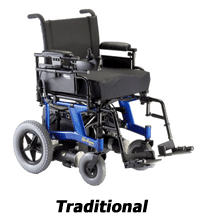

There are a number of other specialty power wheelchairs on the market as well including reclining and (rehab) tilt-in-space wheelchairs. Reclining wheelchairs have a seat backing that is completely independent of the chair allowing for separate functionality. The tilt-in-space wheelchair, on the other hand, not only reclines but completely shifts the weight of the user. The entire chair, including the seat, backing, leg & armrests can be aligned to the user’s preference without assistance.
One of the more recent alternatives to powered mobility is a hybrid or power assist system. This type of wheelchair incorporates a traditional manual wheelchair with the power of electric. The power-assist system is designed to increase the number of revolutions per pass thus giving the user a noticeable increase in propulsion efficiency. The power systems are light enough to be easily attached and remove to the frame of a manual wheelchair making transportation easier.
Understanding the different options available can help you make an informed decision when choosing a wheelchair.
Standard Electric Wheelchairs: These are the most common type of electric wheelchairs, and they are designed for indoor use. They have a traditional design and feature a motor, batteries, and a control system. They are typically lightweight and easy to maneuver, making them ideal for use in small spaces, such as homes and offices.
Heavy-Duty Electric Wheelchairs: These electric wheelchairs are designed for outdoor use and are capable of handling rough terrain. They are typically heavier and more robust than standard electric wheelchairs, and they may have larger wheels, better suspension, and a higher weight capacity.
Foldable Electric Wheelchairs: These electric wheelchairs are designed for easy transportation and storage. They can be folded up for storage in a car trunk or closet. They are lightweight and easy to maneuver but may have less power than other electric wheelchairs.
Standing Electric Wheelchairs: These electric wheelchairs are designed to allow the user to stand up while seated in the wheelchair. They can be used for rehabilitation and to improve circulation, but they are typically more expensive than standard electric wheelchairs.
Outdoor Electric Wheelchairs: These electric wheelchairs are designed for outdoor use, and typically have bigger wheels and better suspension that allow them to handle rough terrain. They are typically heavier and more robust than standard electric wheelchairs.
Specialty Electric Wheelchairs: These electric wheelchairs are designed for specific activities or sports, such as hunting, fishing, or off-roading. They may have specialized features such as all-terrain wheels, increased weight capacity, and more advanced suspension.
When choosing an electric wheelchair, it is important to consider the user’s needs, preferences, and the environment where the wheelchair will be used. Consult with a healthcare professional and a mobility expert to ensure the best fit for the user’s needs.
Drive System & Design Characteristics
Most modern battery powered wheelchairs have designs that can be classified as either Rear Wheel Drive (RWD), Mid Wheel Drive (MWD), or Front Wheel Drive (FWD). Each configuration is determined by the location of the drive system in relation to the users center of gravity. All three systems have unique driving and handling characteristics that will appeal to the different needs of the user.
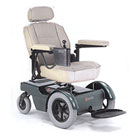
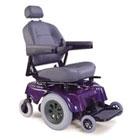
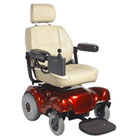
Electric Wheelchair Wheels & Tires
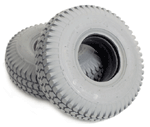
Types of wheels: Electric wheelchairs can have different types of wheels such as polyurethane, pneumatic, or solid rubber. Polyurethane wheels are lightweight and provide a smooth ride, but they are not as durable as other types of wheels. Pneumatic wheels have a rubber tire that is filled with air, which provides a more comfortable ride but they can puncture and need to be refilled. Solid rubber wheels are the most durable and are suitable for rough terrain, but they may not provide as smooth of a ride as other types of wheels.
Types of Tires: Electric wheelchairs can have different types of tires, such as knobby or smooth tires. Knobby tires are designed for off-road use and provide better traction on rough terrain. Smooth tires are designed for indoor use and provide a smooth ride on flat surfaces.
Tire & Wheel Maintenance and Care: It is important to maintain the wheels and tires of an electric wheelchair to ensure the safety and mobility of the chair. Regularly check the tire pressure and replace the tires if they are worn out. Make sure to clean the wheels and tires regularly to keep them in good condition.
When choosing the wheels and tires, it’s important to consider the environment where the wheelchair will be used, and the user’s needs and preferences. It’s also important to consult with a healthcare professional and a mobility expert to ensure the best fit for the user’s needs.
The Controller/Joystick
The controller for most powered wheelchairs is a keypad alongside a joystick that controls both direction and speed. When the joystick is moved in any direction, the brakes disengage and the chair moves. The further you move the joystick from the neutral position the faster it will go. When the chair is put back in a neutral state, it will decelerate, the brakes will re-engage, and the chair stops. The keypad activates other chair functions that you may need. Some wheelchairs offer more sophisticated, alternative wheelchair-controlling devices for individuals that have limited use of their hands. Some of the other controlling options are listed below.
- Sip and Puff – commands are given by inhaling or exhaling with an attached tube.
- Head Controls – switches are added to the sides of the headrest.
- Foot Controls – pedals and buttons are added to the footrests of the wheelchair.
- Chin Controls – the controller is mounted near the chin.
- Speech Controls – the controller uses a simple speech recognition program.
Electric Wheelchair Batteries
The batteries of an electric wheelchair are a critical component that powers the chair. Different types of batteries can be used depending on the user’s needs and preferences.
Types of Batteries: Electric wheelchairs can have different types of batteries, such as sealed lead-acid (SLA) or lithium-ion (Li-ion) batteries. Sealed lead-acid batteries are the most common type of battery used in electric wheelchairs and are typically less expensive. Lithium-ion batteries are more expensive, but they have a longer lifespan and are lighter in weight.
Battery Life and Maintenance: The battery life of an electric wheelchair will depend on the type of battery used, as well as the usage of the chair. It is important to regularly check the battery level and charge the batteries when necessary. Properly maintaining the batteries can help prolong their lifespan.
Power wheelchairs typically utilize 2 – 12 volt deep cycle batteries that must be re-charged on a regular basis. The batteries make them significantly heavier than most manually powered chairs, making it necessary for the wheelchairs to be manufactured with a stronger sturdier frame to support the battery, motor, the user, and any additional adaptive equipment. The range of the battery will often depend on a number of factors including: the users weight, ground level, and temperature.
When choosing a battery, it’s important to consider the user’s needs and preferences, as well as the environment where the wheelchair will be used. It’s also important to consult with a healthcare professional and a mobility expert to ensure the best fit for the user’s needs.
Medicare and Insurance
With your doctor’s approval, Medicare should cover 80% of your wheelchair. Your supplemental or secondary insurance will cover the remainder. Medicare must be your primary insurance carrier in order to file the initial claim with them. If you have secondary insurance, often they will pay any remaining amount that Medicare did not cover. If Medicare is your secondary insurance carrier, you must first file a claim with your primary insurance carrier, wait until you are reimbursed by them, and then file with Medicare with any remaining balance.
Most of the cost of your electric wheelchair should be covered under your medicare part B coverage. To qualify for this you must meet all of the criteria below:
- Your doctor must write the order for a power wheelchair and inform Medicare of the need.
- Your powered mobility device must be medically necessary.
- You must be able to operate the wheelchair (must also be in writing by the doctor)
- You are limited in respect to your normal daily activities.
- You must be able to safely operate the wheelchair or have someone with you that can help.
- You must be able to use the equipment in your home and have accessible entrances and exits.
Medicare Part B will pay up to 80% of the cost of your electric wheelchair from a Medicare-approved provider but you will have to meet your yearly deductible first
One cheaper, short term option to consider (if you don’t need a wheelchair for over longer than 6 months) is to rent an electric wheelchair. Renting durable medical equipment like this will ultimately lower your costs and if you wind up needing it for longer you can always buy it. Talk with your preferred electric wheelchair supplier to find out what options you may have.
Medical insurance can help cover the cost of an electric wheelchair, but the coverage and process can vary depending on the insurance provider and the individual’s policy.
Coverage for electric wheelchairs: Many insurance policies cover the cost of an electric wheelchair, but the coverage may vary depending on the policy. Some insurance providers may require pre-approval before covering the cost, while others may have a cap on the amount they will cover. It is important to check with the insurance provider to understand the coverage for an electric wheelchair.
How to apply for coverage: The process for applying for coverage for an electric wheelchair can vary depending on the insurance provider. Typically, a healthcare professional or mobility expert will provide a prescription for the wheelchair and submit a claim to the insurance provider. It is important to keep all documentation, such as the prescription and bill, to ensure a smooth process.
It is important to check with the insurance provider and consult with a healthcare professional and a mobility expert to understand the coverage and process of obtaining an electric wheelchair through medical insurance.
Other Considerations
When choosing an electric wheelchair, there are several other considerations that should be taken into account to ensure the best fit for the user’s needs.
Safety and accessibility: Safety is a crucial factor to consider when choosing an electric wheelchair. It is important to ensure that the wheelchair meets the safety standards and that the user is able to operate the wheelchair safely. It is also important to consider the accessibility of the environment where the wheelchair will be used, such as ensuring that the wheelchair can fit through doorways and navigate obstacles.
Accessories and modifications: Electric wheelchairs can come with different accessories and modifications that can enhance the user’s experience and meet their needs. Some examples of accessories include cup holders, oxygen tank holders, and bags for carrying personal items. Modifications can include adding power seating, adjustable legrests and elevating seat, which can make the user more comfortable.
Cost and financing options: Electric wheelchairs can be expensive, and it’s important to consider the cost when choosing a wheelchair. Many insurance policies will cover the cost of an electric wheelchair, but it’s important to check with the insurance provider to understand the coverage. Financing options such as loans or leasing may also be available.
When taking these considerations into account, it is important to consult with a healthcare professional and a mobility expert to ensure the best fit for the user’s needs and preferences.
How to maintain and repair an electric wheelchair
Maintaining and repairing an electric wheelchair is important to ensure the safety, mobility, and longevity of the chair.
Regularly check and maintain the following components:
- Check and maintain the battery level, and ensure that the battery is fully charged and working efficiently.
- Check and maintain the wheels and tires, make sure that they are in good condition and at the correct tire pressure.
- Check and maintain the drive system, and ensure that the motor and control system are working properly.
- Check and maintain the controller, ensure that it is working properly, and that the buttons and switches are responsive.
Regularly clean the wheelchair:
- Clean the frame of the wheelchair, use a damp cloth or mild detergent to wipe down the frame.
- Clean the upholstery, use a damp cloth or mild detergent to wipe down the seat, backrest, and armrests.
- Clean the wheels and tires, use a damp cloth or mild detergent to wipe down the wheels and tires.
- Regularly check for any worn out or damaged parts:
Check for any worn out or damaged parts and replace them as soon as possible. Keep the manual and any documents that came with the wheelchair in a safe place, so you can refer to them if you need help with repairs or maintenance.
When maintenance or repairs are needed, it is important to consult with the manufacturer or a mobility expert to ensure that the work is done correctly and that any parts used are compatible with the wheelchair.
Leading Manufacturers
Invacare – Invacare is an industry leader in the $6-billion market for home medical products, manufacturing and distributing the world’s broadest product offering to approximately 15,000 independent, home medical equipment (HME) providers. Invacare reports results along three geographic segments (North America, Europe, and Australasia) and groups its products into four distinct product categories (Standard, Rehab, Medical Supplies, and Respiratory).
Permobil – One of the most respected names in power wheelchairs. Permobil chairs are light, and strong and offer features that can be customized to an individual’s needs, like programmable electronics, a choice of operating systems (joystick, head control, sip-and-puff control, etc.), and a range of power options.
Sunrise Medical – Sunrise Medical is one of the world’s largest manufacturers of homecare and extended care products. Founded in 1983, the Sunrise Medical family of products has been built from many of the most popular brands in the homecare industry including Quickie, Sopur, Jay, DeVilbiss, Hoyer, Guardian, Coopers, Oxford and Joerns. Sunrise operates manufacturing facilities in the United States, Mexico, the United Kingdom, Germany, and Spain.
Pride Mobility Products Corp – Pride Mobility is an industry leader in the design, development, and manufacture of mobility products—power chairs, scooters, and lift chairs—and is an enduring organization comprised of persons committed to the service of individuals with disabilities and mobility impairments.
Teftec Mobility – Teftec specializes in designing, assembling, and marketing motorized wheelchairs. Introduced the TransmissionSteering™ system.
Drive Medical – Drive Medical was founded in 2000 and has quickly become a leader in the manufacturing of durable medical supplies (including power wheelchairs) and other mobility equipment.
Electric Wheelchair Stores & Suppliers
AllDayMedical.net – We offer a large selection of motorized wheelchairs at unbeatable prices. Choose from portable as well as folding power wheelchairs.
SpinLife.com – Shop SpinLife for a complete selection of electric wheelchairs. Choose from Jazzys, Jets, Prontos and more. Prices start at just $1199 with free shipping. Medicare billing is available.
Easy Med Online – EasyMedOnline.com specializes in Power Wheelchairs, Electric Wheelchairs, and Power Chairs all across the United States. We have service and technicians across the country to provide in-home set-up and delivery, in addition to billing Medicare if you qualify. Receive up to 40% discounts and 110% price guarantee.
Jazzy Electric Wheelchairs – Jazzy, Shoprider, and Golden electric wheelchairs starting at $1449. Call us for the best prices. Free delivery, in home set up and in home warranty service.
1-800-Wheelchair.com – All Styles Of Electric Wheelchairs. Discount Prices from $1199. 1-800-Wheelchair carries Pride, Invacare, Golden & more. Call or Order Online. Free Shipping.
Vitality Medical – Wholesale prices on electric wheelchairs and other mobility devices like scooters. For over a decade, Vitality Medical has provided great customer service. Free shipping on orders over $100.
Electric Wheelchair FAQs
Here are some electric wheelchair frequently asked questions
How fast can an electric wheelchair go?
The speed of your power chair will typically depend on the model. The top baseline speed of most electric wheelchairs and many other powered mobility vehicles is about 4-5 MPH. There are, however, several brands/models that can travel even faster and are built for speed. According to 21st Century Scientific, their BOUNDER power chair series can reach speeds up to 11.6 MPH and is the fastest electric wheelchair.
How far can an electric wheelchair go?
The distance a power chair can travel, or range, will largely depend on the model and its intended use. Many manufacturers will quote a range of 20 – 25 miles for a typical power chair. Ultimately, the range of your electric wheelchair will depend on a number of factors including wheelchair battery type, battery age, battery size, the weight of the rider, maximum driven speed, drive train efficiency, driver behavior, and the terrain. In general, the use of a wet-cell wheelchair battery will also increase the range. Range is an important metric that should be considered in the selection and design of a power wheelchair.
Are electric wheelchairs covered under insurance?
Many insurance policies, including Medicare and Medicaid, cover the cost of an electric wheelchair as durable medical equipment (DME). However, the coverage and process can vary depending on the insurance provider and the individual’s policy. Some insurance providers may require pre-approval before covering the cost, while others may have a cap on the amount they will cover. It is important to check with the insurance provider to understand the coverage for an electric wheelchair and consult with a healthcare professional and a mobility expert to ensure the best fit for the user’s needs. It is also important to note that some insurance plans may require that the wheelchair meet certain criteria for coverage, such as the wheelchair being medically necessary for the individual’s condition.
Medicare typically covers power wheelchairs for individuals who are unable to use a manual wheelchair and are unable to perform activities of daily living (ADLs) in their homes due to mobility impairment. In order for Medicare to cover a power wheelchair, the individual must have a face-to-face evaluation with their physician, and the physician must certify that the power wheelchair is medically necessary for the individual’s condition.
Medicare typically pays for a power wheelchair every 5 years, however, it’s important to check with the specific insurance provider and consult with a healthcare professional and a mobility expert to understand the coverage and process of obtaining a power wheelchair through Medicare.
It’s also important to note that some Medicare Advantage plans may have different coverage and processes for power wheelchairs. So it’s always best to check with the specific plan to understand the coverage.
What is the lifespan of an electric wheelchair?
The lifespan of an electric wheelchair can vary depending on the model, usage, and maintenance of the chair. On average, an electric wheelchair can last between 3 to 5 years with proper maintenance. However, with consistent usage, the lifespan of the batteries can be shorter around 2 years, and it may need to be replaced.
The lifespan of an electric wheelchair can be extended with proper maintenance and care. This includes regularly checking and maintaining the battery, wheels and tires, drive system, and controller. It’s also important to regularly clean the wheelchair and check for any worn out or damaged parts. Additionally, it’s important to follow the manufacturer’s recommendations for use and storage, and if needed, repair or replace any worn-out parts.
It’s also important to note that some factors such as the weight of the user, usage, and the environment can affect the lifespan of an electric wheelchair. It’s always best to consult with the manufacturer or a mobility expert to have a better understanding of the lifespan of the specific model of electric wheelchairs.
How far can an electric wheelchair go on one charge?
The distance an electric wheelchair can go on one charge can vary depending on the specific model, battery type, and usage.
In general, electric wheelchairs with smaller batteries and lower voltage will have a shorter distance range on one charge, while electric wheelchairs with larger batteries and higher voltage will have a longer distance range.
A typical distance range for an electric wheelchair on one charge can be between 10-15 miles, but it could be more or less depending on the specific model and usage. Factors such as the weight of the user, terrain, and the use of additional features such as power seating or elevating seats can affect the distance range.
It’s important to consult with the manufacturer or a mobility expert to understand the specific distance range for a particular model of electric wheelchair. It’s also important to regularly check the battery level and charge the batteries when necessary to ensure optimal performance.
Resources
Here are a few electric wheelchair guides and resources.
- Tips and Reviews for powered wheelchairs – Great reviews from Rick at Edmond Wheelchair Repair and Supply
- Informed Consumer’s Guide to Funding Assistive Technology
- Electric Wheelchair and Disability Links
- Wheelchair Junkie Articles – Great articles – Excellent resource.
- Guide to Buying – From Spinlife.com


